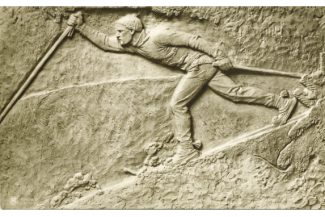Ski Art: Carl Vilhelm Fagerberg (1878-1948)

Carl Fagerberg understood athletic technique. His sculptures captured the powerful grace of elite athletes, with several of them submitted in art competitions for the Olympic Games.
Carl Fagerberg is one of Sweden’s most respected sculptors. After completing an apprenticeship in carpentry, he attended the Technical University in Stockholm and also the capital’s Kungliga Konsthögskolan, the Royal Art Academy. In 1906, he was awarded the prestigious Jenny Lind scholarship for three years, which allowed him extensive travel to France, Germany and Russia, where he received a commission from the Tsar for stucco work in the St. Petersburg railway station.
In 1908, he set up his own studio in Stockholm and two years later traveled to Italy, Spain and Tunis. As a young man, he was also keen on sports, including skiing.
Fagerberg worked in granite, bronze and porcelain, and the results enhanced many different venues. He embellished churches and public buildings. His decoration of the Swedish church in Paris, for example, and Goteborg’s telegraph office are two of many sculptures, which can be admired in Skelleftea, Gavre, Lulea, Örebro, Linköping and Eskilstuna, too. Fagerberg was also known for his animal sculptures. In addition, he designed medals and medallions, and worked as a painter.
His dynamic sporting sculptures, some of which can be seen in Stockholm’s Olympic stadium, were submitted for the art competitions in the Olympic Games. At the Los Angeles Games of 1932 Fagerberg received honorable mention for his skater, and at Berlin in 1936, his baton passing of relay runners was much admired but received no prize.
Fagerberg's sporting scenes were full of energy and action. And that is what makes his circa-1916 sculpted figure Skidlöpare—Skier—so powerful. The skier, in full athletic stride, is well balanced and in control as he
descends a slope. Fagerberg knew his ski technique.
Fagerberg’s work is also exhibited in the National
Museum in Stockholm and in the Kalmar Art Museum. When Fagerberg was working, Sundbyberg was just outside Stockholm’s city limits but now is in the northern part of the city. The Sundbyberg museum holds two skiing sculptures. One has an unusual subject: a woman bending down trying to get her bindings just right.